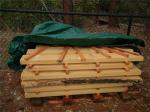This is like rehab, getting off of the power grid, but its not a 12-step to recovery – it’s only a 10-step toward power independence.
- Determine your historical energy use from your past electric bills. Pay attention to the difference between summer and winter power usage.
- Determine your roof area available for photovoltaic panels. the panels mounted on your roof or ground contain the photovoltaic (PV) cells which convert sunlight into DC power. South facing surface areas are best but seasonal variations in sun exposure allow for a variety of solar panel placements to be used.
- Contact a licensed and approved solar installation contractor such as Automation Solar in your area to perform an on-site consultation. Your contractors will know all the current solar technologies available and how to take advantage of all possible federal, state, and possibly local solar tax rebates.
- The solar installation contractor will determine best location for your photovoltaic panels and best inverters to use for the size of the solar system. Location of solar panels may vary as well as type of panels. Inverters (which convert the solar panel current from DC to usable AC current) need to be chosen based on best size and type for the system as does the production meter (explained below). The power from the solar panels are sent to an inverter (or power converter) which converts the DC electricity from the solar modules to AC power, which is the same type of power being sent from your utility company to your home or business.
- Discuss technological tools to be used in the analysis as well as installation. Sometimes shading is worthy of a serious analysis.
- Discuss all costs for various solar electric system options and installation timing with your solar installation contractor to finalize all variables. Once all is decided upon it is the time to sign the contract. Your solar installation contractor will submit applications to your electric utility and begin paperwork with all possible federal, state, and possibly local tax credits and rebates, etc., to save you the most money possible.
- You will then sign an agreement with your electric utility. This is called a Net Metering Agreement and states that the power utility will credit the excess power you produce which flows to the power grid. Also an important consideration is the use of a smart meter monitor. This will allow you to be given credit for power you generate at different rates. These rates can be peak and off peak rates. These rates are dependent on time of day you produce power, day of the week, and month of the year. Peak rates are often summer afternoon week days. If you send power to the power grid during peak times of the day, you will get credit at the higher, peak rate. If all of the electricity being generated by your solar energy system is immediately being used, your meter will not “spin backwards”.
- Your solar installer will generate designs and pull all permits needed and, when you are ready, will install your solar system. Once completely installed your county or city will inspect the system to insure compliance of your system and insure you are eligible for the solar tax rebates and / or benefits you have applied for.
- Your utility company will be sending you your solar rebate check 6 to 8 weeks after inspection of system.
- Enjoy decades of environmentally friendly and maintenance-free power. Give yourself a “good job” for saving money and helping the planet. Good luck and know that PV solar pros are out there. Give them a ring.
Glenn Forslin is President & CEO of Automation Solar, a solar cosulting and installation company for residential and commercial applications.








Makes total sense. Thanks, this is helpful to new buyers of Solar Power Systems.
clearly, the hotter the water, the more you save.i don’t unrsdetand why that would be a question.when you use cold water, do the dishes come out clean?many washers don’t heat the water — the heating coils are only used in the dry cycle.you’d probably not want to use water directly from the solar panels.you’d get a little hot water, and the rest cold — it wouldn’t have time to heat.you want a tank so that the water can continuously circulate and gather energy all day.that would work far better.considering how expensive it is to heat water, i’m a big fan of solar hot water.